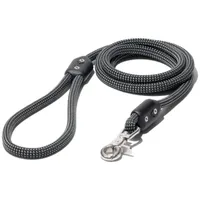Want to enjoy an stress-free stroll with your reactive dog? This trainer's advice is well worth considering
Make life easier for your pup, and yourself, too.

As many dog parents will know, walking a reactive dog can be difficult. While it isn’t the dog’s fault, the experience can be stressful and you might find yourself going away from the most popular routes, walking at less busy times, or simply just being more on edge than you would otherwise.
If you have a reactive dog, it can make sense to revisit your approach when it comes to walking them, to see if there’s anything you can change. It’s all well and good to use one of the best dog leashes and bring treats with you, but what else can help?
Fortunately, the professional dog trainer and behavioral consultant Amelia Steele, or Amelia the Dog Trainer, has explained all we need to know in a new Instagram post, and it’s absolutely invaluable.
A post shared by Amelia Steele (@ameliathedogtrainer)
A photo posted by on
Atlas Pet Company Lifetime Leash
If you're looking for a high-quality long leash, then this one is a great option. It's made from dry-treated dynamic climbing rope, meaning it's suitable for strong dogs and lasts a "lifetime" (hence the name). Our tester Sarah tried it out on her dog Duke, and describes it as strong, sturdy and game-changing.
“When we really think about what a walk is for,” Steele begins, “It’s supposed to be time for a dog to de-stress, decompress, and burn off energy. When we’re dealing with reactivity, often the walk itself becomes a primary stressor, and when a dog’s going out on a walk expecting to go out and bark at things and expecting to be stressed, all it does is add fuel to the fire.”
She explains that, instead, when it comes to reactivity in dogs we should look at other ways in which they can be fulfilled without constantly being exposed to their triggers.
“If our dogs are just constantly topping up and topping up that adrenaline and then not having a chance to just enjoy themselves, then this is going to increase that baseline level of anxiety or stress, and it’s going to be much harder for them to take in new information and progress through their training.”
Steele recommends introducing an active management system or simply giving your dog the chance to go on walks where they’re out of the way of anything that might be stressful for them, even if that’s hiring a private field or driving further away.
Get the best advice, tips and top tech for your beloved Pets
As she explains in the caption, “We want to start by giving our dogs alternative ways to feel fulfilled while simultaneously introducing management to allow our dogs to go out and enjoy stress-free walks. Once we’ve got this sorted it’s so much easier to later add training on top.”
Training is great, but if you start training without considering everything else, your dog might not be in the right frame of mind to learn, and training could be more difficult than it needs to be. If you’re struggling with your reactive dog and would like some more advice, you might find this article useful, too: Owning a reactive dog is hard. Here's how I navigated the social challenges with my pooch.
We’re rounding up the best Black Friday dog deals for dog owners so be sure to check them out!

Adam is a freelance journalist specialising in pets, music and culture, and mental health and wellbeing. He investigates and writes the large majority of news on PetsRadar, and collaborates with veterinary experts to produce informative pet care content.
Adam has a journalism degree from Southampton Solent University and a masters degree in Magazine Journalism from Cardiff University. He was previously senior editor at dog advice website DogTime.com, and has also written for The Independent, GoodToKnow and Healthline.
He owns two rescue cats, Bunny and Dougie, and has also previously had a rabbit, fish and Roborovski dwarf hamsters.

